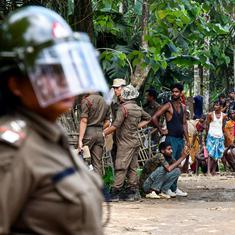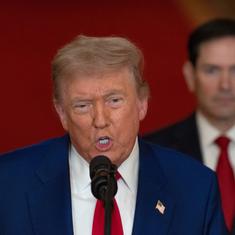Recently, a reporter with an English daily in Kashmir wrote a story on daily wage earners trying to feed their families during the lockdown to contain the coronavirus. Some said they were running out of money to buy food and medicine, and had not got government rations.
To get the government’s version, she contacted a senior official in the Srinagar administration. “He provided me with details on WhatsApp – this number of families have been given food, this is the number of food kits we are distributing,” she said. “But then he said he is not to be quoted.”
The journalist needed an official quote on record. “When I called him asking for an official response, the call was forwarded,” she said. “When I called his spokesperson, he said he was not available.”
The reporter did not use the information given off the record. In the end, the story was published with a line at the bottom saying that particular government official was not available for comment. The same day, the editor of the newspaper received an irate call from the official.
A few days earlier, she had a story on a fire in one of the “red zones” of Srinagar. These are areas that have been declared coronavirus hotspots and sealed off, with semi-permanent iron barricades drilled into many of the entry points. As a result, she said, the firemen took time to reach the spot.
“I called up officials who said they did have troubling reaching, but it was off the record,” she said. “After the story was published, they called up my editor saying the story was ‘fake news’.”
‘Not available for comment’
For another reporter, similar allegations took a more drastic turn. On April 19, the Jammu and Kashmir police summoned Peerzada Ashiq, the Hindu’s Kashmir correspondent, to interrogate him about a report. The police also filed an FIR taking cognisance of the “fake news item”.
The report was on the funeral rites of militants killed in a gunfight with security forces in South Kashmir’s Shopian district. They had been buried by security forces in North Kashmir’s Baramulla district. The report in question quoted the uncle of one of the militants who had been killed, who believed the police had given permission to exhume the body. It turned out they had only granted the family permission to visit Baramulla during the Covid-19 lockdown.
The details of the report were factually incorrect, said a police statement released on April 20, it could “cause fear or alarm in the minds of public”. The news had been published without seeking confirmation from the district authorities, the statement went on to say, and could the media fraternity please refrain from publishing “fake/fabricated news stories” which had no official confirmation.
Yet the report had also said “Yasin Choudhary, Deputy Commissioner, Shopian, was not available for his comment”. Ashiq told the Committee to Protect Journalists he had tried to reach out to the authorities and had even shown his interrogators screenshots of questions sent to officials.
According to the Hindu, “No rejoinder/clarification was received by the newspaper prior to the registration of the FIR either from the police or from the information department.”

The discovery of ‘fake news’
It is a familiar story in Kashmir, journalists reaching out to government or security forces to get the official version of events, only to be stonewalled. In the absence of official confirmation, reports are published with the caveat that they would be updated if there was a response.
“It is difficult to talk because sometimes they talk and sometimes they don’t,” said Muzaffar Raina, the Telegraph’s Kashmir correspondent. “But most of the time they feel they are above accountability.”
Yet this lack of official confirmation has been used to discredit news reports. The local administration also tweeted a “fact check” of an earlier report by Ashiq, which claimed 5,000 Covid-19 testing kits bound for Srinagar had been diverted to Jammu. The report had quoted officials speaking anonymously, who claimed health officials had raised an alarm over the testing kits.
Yusuf Jameel, a veteran journalist in Kashmir, is mystified by the new official language of “fake news” and “fact checks”, replacing the “denials” and “rebuttals”. “What do you mean by fake news?” he said. “They could say this is our rejoinder.”
From “fake news”, journalists point out, it is a short step to “anti-national” content criminalised through FIRs. “Not just the regular police, but the cyber police is dealing with a report in a newspaper,” pointed out one senior Kashmiri journalist who did not want to be named.
Post August 5
Journalists in Kashmir describe a firm closing of official ranks after August 5, when the Centre stripped Jammu and Kashmir of special status under Article 370 and split the state into two Union Territories.
“The flow of information is very low, in some cases, zero, from the government side,” said Jameel. “It is very difficult to get in touch with authorities, especially after August 5. They would speak off the record, now they are very reluctant to talk and won’t take calls. Some will say they are not authorised to speak or give sketchy details. If you speak to the police’s PR person, he will say ‘I am not authorised to talk’.”
Often, Jameel continued, security officials would delay comments, which meant daily news stories had to go without official versions. “It is very difficult, when you have to meet deadlines, if they get back only in the evening or the next morning,” he explained.
In the aftermath of August 5, the local administration had streamlined communication to a daily press briefing held at a newly set up “media centre” in a plush Srinagar hotel. After those briefings petered out, official sources largely spoke to a few journalists considered sympathetic to the government, reporters complained.
“We have been pleading with the administration to authorise someone to talk,” said Jameel. “There has to be some mechanism [to communicate]. After that, if they feel there has been exaggeration or facts are incorrect, we won’t have any complaints.”
On April 22, for instance, reporters in Kashmir were struggling to pin down the details of a gunfight in Shopian district that morning. Four militants had been killed, according to official sources. But was a house where the militants were said to be hiding blown up, as some photographs suggested? Which group did the militants belong to? No official source would confirm.
These days, much of the official communication has moved to social media, with occasional press conferences thrown in. “They will put out details of operations on Facebook and Twitter, but it will be the government version,” said the senior journalist. “If you ask questions, you hit a wall.”

‘An onslaught on journalism’
Threats, intimidation and violence have been a Kashmiri reporter’s occupational hazards for three decades now. “Right from 1989-’90, when militancy started, they [official sources] would withhold information, give out half truths,” said Jameel, who reported from the Valley in those turbulent years. “Things were bad in the early 1990s. We faced a lot of problems from the militant side. And security forces would accuse you of being hand in glove with militants if you didn’t toe their line.”
As the Valley entered an era of civil protests in 2008, there was a further tightening of information. “They developed standard operating procedures to deal with what they called law and order situations – one of them was to keep the media away from protest sites,” said the senior journalist. Video-journalists trying to record stone pelting and protests were routinely intimidated or roughed up.
“Earlier it was militants versus military, post-2008 there was a shift – it became state versus public,” he continued. “As Kashmiris started taking control of their own narrative, they [officials] also changed tactics.” As specific names in the administration became objects of public anger, officials retreated into anonymity, choosing to speak off the record.
But the last nine months had seen a “dramatic escalation” in the crackdown on the media, he felt. “It has become a deliberate thing,” he said. “To force you into self-censorship, into not questioning authority or seeking details beyond official handouts. This is not about individuals, it is an onslaught on the practice of journalism.”










